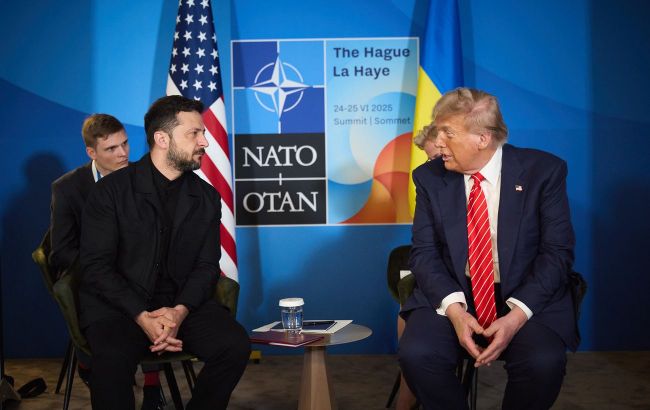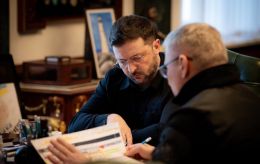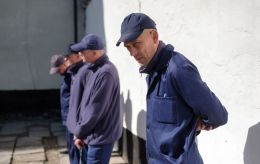From Alaska to Washington: Three scenarios for Zelenskyy's meeting with Trump
 Volodymyr Zelenskyy and Donald Trump (photo: president.gov.ua)
Volodymyr Zelenskyy and Donald Trump (photo: president.gov.ua)
What to expect from today’s meeting of the Ukrainian and American presidents at the White House and how Ukraine may be pushed into territorial concessions – read the RBC-Ukraine article below.
The hyper-intensive diplomacy, which began with Steve Witkoff’s visit to Moscow on August 6, is not slowing down. Literally on the third day after the meeting with Putin in Alaska, Donald Trump in Washington will host Volodymyr Zelenskyy and a group of European leaders. And Axios sources report that in the US, they would like to hold a trilateral summit among Trump, Zelenskyy, and Putin as early as this Friday, August 22 – although such speed seems remarkable even by today’s standards.
The meeting in Alaska itself went according to the worst of the scenarios described the day before by RBC-Ukraine. Despite the multi-day preparation by European leaders, Trump completely forgot about his main task – to extract from Putin consent to a ceasefire. On the contrary, it seems he fully accepted the approach proposed by Putin – no temporary truce; what is needed is an immediate comprehensive peace treaty. Which, of course, will take into account the elimination of the root causes of the conflict and Russia's legitimate interests in the sphere of security.
Moreover, Trump, judging by leaks into Western media, also agreed with the Russian vision of these interests – in particular, on the issue of concessions by Ukraine of its territory.
However, the fatal scenario has been avoided so far – Trump publicly agrees, and even emphasizes, that without Ukraine’s consent, no agreements can be concluded.

Volodymyr Putin and Donald Trump in Alaska (photo: Getty Images)
Explaining why Ukraine cannot agree to Russian conditions, Trump will be told personally by Zelenskyy. Importantly, in the company of some European leaders, among whom are also those whom Trump is quite fond of: President of Finland Alexander Stubb and Prime Minister of Italy Giorgia Meloni.
Thus, it is likely that it will be possible to reduce the risk of "Oval Office №2" – because the demands of the Kremlin, voiced (and seemingly supported) by Trump, cannot but provoke a stormy reaction in Zelenskyy, with no less stormy a response from the host of the venue. However, according to the schedule, at first, Trump will still spend an hour face-to-face with Zelenskyy; Europeans are to join later. But even if a scandal can be avoided, the further course of events will be no less unpredictable than after the meeting in Alaska.
Trump can be persuaded
With joint efforts, Zelenskyy, Meloni, Stubb, and company may return Trump to the correct path, destroying the thought-viruses which in Alaska, Putin planted in his head. In particular, to explain that for an everyday conversation about peace to begin, first of all it is necessary to stop shooting; that Russia is by no means winning on the battlefield, and its army is by no means invincible; that the refusal of Putin from advancing in Kherson and Zaporizhzhia regions is empty sound, because Russia has long not advanced there; that no guarantees from Russia are possible in principle, and so on.
If today’s guests of the Oval Office really can convince Trump of these not so complicated things, then before the American leader a new fork will appear: how to act further, since with "friend Vladimir" in Alaska it was already possible to "agree on many things." Perhaps, it is worth expecting a new visit of Witkoff to Moscow, with an updated package of instructions. And further rounds of meetings, negotiations, and consultations.
But taking into account Trump’s noticeable impatience, the amount of time and effort he has invested in "reaching an agreement" in recent days looks frankly unlikely.
Trump exits the game
Much more likely looks another reaction of the American leader to the insistence from Ukraine and Europe, their unwillingness to agree with Kremlin conditions – Trump will once again understand how far apart are the positions of Ukraine (+ Europe) and Russia, and bringing them closer is impossible. Therefore, it is just the time to fulfill his old promise – to completely withdraw from negotiations, simply "to go away."
As if to say, I did everything I could, but "they want to keep fighting" – and I cannot prevent it in any way, so let them fight.
Here, of course, two sub-variants are possible, because one can leave in different ways. Either loudly slamming the door, placing most of the blame on Ukraine and ceasing to supply it with any assistance. Or leaving functioning the recently launched PURL program, under which Europe buys weapons for Ukraine.
The second option fully fits into the logic and rhetoric of American leadership: we certainly will not help Ukraine just like that, but if Europe is ready to pay – then there is no problem, it is business. Europe on its side looks more cheerful and coordinated than a few months ago, but nevertheless, everyone admits that without the active participation of the USA, no security guarantees for construction are possible.
Trump sets an ultimatum
Finally, so far, the most likely scenario – Trump, given his obvious desire to "end the war" and receive this reward in the form of the Nobel Prize, will not slam the door just like that. But will present to Ukraine, in fact, an ultimatum: either go on Russian terms, or no support.
The main element of the ultimatum, without a doubt, is territories, namely the withdrawal of Ukrainian troops from all of Donbas. Although among Putin’s “wish-list” there are also other demands, such as the status of the Russian language and the Russian church, according to information of RBC-Ukraine, the main emphasis was placed precisely on territorial issues.
Literally on the eve of the meeting, confirmations appeared that the question of Donbas would be the main one today. "Tomorrow, the issue of territories will be discussed with Zelenskyy," said Witkoff on Sunday. And Trump himself reposted in Truth Social a post about how it is better for Ukraine to give away some lands now, because in the case of continuation of the war "it will keep losing even more land." Later, Trump quite transparently hinted that among the concessions which he intends to extract from Ukraine is a refusal to return Crimea.
However, there are also other signals: for example, Secretary of State Marco Rubio, almost simultaneously with Witkoff, declared that no one will force Ukrainians to give away all territories which Russia claims. Whether it means that in the vision of the State Department, Ukraine may give away some part of them is unknown. Probably, such discord testifies that in Trump’s team overall, there are different opinions regarding how much to “press” Ukraine. And Rubio is usually attributed to the conditional pro-Ukrainian wing in Trump’s administration, unlike Witkoff.
Anyway, if Trump bluntly puts the issue of territories before Zelenskyy, then the Ukrainian president will already find himself at a crossroads.
On one hand, in recent days, he has repeatedly declared that Ukraine will not give up its territories, the same was voiced in telephone conversations with Trump. "We need real negotiations, which means they can start where the front line is now. The contact line is the best line for talking. And Europeans support this," said Zelenskyy on Sunday.
Any significant retreat from the frontline has colossal potential for internal conflict. Such a betrayal in all three and a half years of the big war has never been even close. And the interlocutors of the publication in the presidential team also understand this.
Already now, as soon as the topic of "exchange of territories" appeared in the information space, heated debates rage in social networks. One can imagine their scale (with potential spillover offline), if concession of territories from a scenario turns into reality. Not only for Zelenskyy’s team, but for all of Ukraine, this can lead to the saddest consequences.
But are any compromises possible in principle? On this point, there is no clarity; RBC-Ukraine sources give contradictory signals.
In theory, of course, in exchange for such a weighty concession as surrender of territory, one can try to obtain quite a lot: first of all, no restrictions on Ukraine’s internal and external policy—secondly, truly weighty guarantees, the best of which are weapons.
In Trump’s administration, one of such is seen as certain obligations of Ukraine to the USA, analogous to Article 5 of the North Atlantic Treaty – about collective defense of NATO member states. That is, when an attack on one country is considered an attack on its partners as well. However, in the effectiveness of Article 5 there are big doubts even among some current NATO members, not to mention its application to Ukraine in some hybrid format.
Still more ephemeral looks another guarantee voiced by Witkoff – some kind of "legislative obligation" of Russia not to attack Ukraine and Europe anymore. The weight of such an obligation will not exceed the “guarantees” provided by the Budapest Memorandum.
Witkoff himself has been dealing with the topic of the Russian-Ukrainian war relatively recently. Otherwise, he could recall the statement of the head of the MFA of the Russian Federation, Sergey Lavrov, from June 2022: "We did not attack anyone." In this way not to attack the aggressor country may still many more times, and no "legislative obligations" are an obstacle to that a priori.
But to convey all these arguments to Trump, and in such a way as not to drive him out of temper – a task with three stars. Therefore, today, possibly, one of the most difficult days of the entire great war awaits Zelenskyy.

